Your bread is taking longer to bake outside today due to several environmental factors affecting your solar oven's performance. Cloud cover reduces air density and temperature, while wind can create uneven heat distribution and cause rapid cooling of your oven's surfaces. These conditions typically extend baking times by up to two hours and affect yeast activity, which works best between 75-78°F. You'll need to monitor your dough temperature closely and may need to adjust your recipe, including reducing yeast by 10% in cloudy conditions. Understanding these natural elements will help you master the art of outdoor baking.
Understanding Solar Oven Temperature Fluctuations
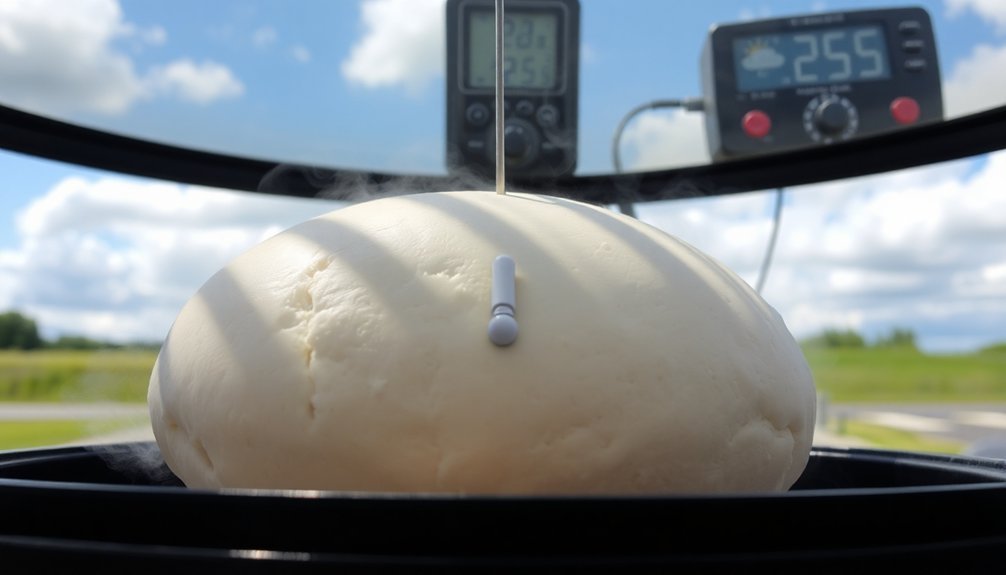
While traditional ovens maintain temperatures through electronic controls, solar ovens rely on the sun's energy and proper insulation to create a stable cooking environment.
You'll notice that solar ovens actually provide more consistent temperatures than standard ovens, which can fluctuate up to 40°F around their set point.
A well-designed solar oven can reach temperatures between 250°F and 400°F, with box ovens typically operating at 325-350°F.
You'll need to take into account several factors that affect your oven's temperature stability. Wind can dramatically reduce internal heat, so choose a protected location. The slow cooking process enhances the natural flavors of your food while taking about 30% longer than traditional methods.
Your geographical position matters too – southern locations receive more intense sunlight.
To maintain ideal cooking temperatures, you'll want to adjust your oven's position regularly and use reflectors to enhance heat collection.
Cloud Cover Effects
When you're baking bread outdoors, cloud cover greatly changes the air density, making your dough behave differently than on clear days.
You'll notice that cloudy conditions create lighter, less dense air that allows dough to rise more readily, though this can lead to unexpected proofing times.
The clouds also indirectly impact temperature, creating a cooler environment that slows down yeast activity and requires longer fermentation periods. For best results, try reducing yeast by 10% to better control the fermentation process in these variable conditions.
Air Density Changes
Since cloud cover greatly affects air density and temperature, your bread's fermentation process can slow down markedly outdoors.
When clouds block direct sunlight, the ambient temperature drops, causing yeast to become less active. This means your dough will need more time to rise properly. Just like in higher altitude locations, bread dough tends to rise at different speeds based on atmospheric conditions.
You'll notice that cloudy conditions often bring higher humidity levels, which can impact how your flour absorbs moisture.
Your dough might feel stickier and harder to handle, especially if you're working with high-hydration recipes. The extra moisture in the air can also affect how your bread's crust develops during baking.
While cloud cover won't markedly change atmospheric pressure, it's the combination of cooler temperatures and increased humidity that makes your outdoor bread-making process take longer than usual.
Indirect Temperature Impact
Cloud cover creates a complex interplay of temperature effects that goes beyond simple sunlight blocking. When clouds shield your outdoor baking area, you'll notice slower yeast activity and more stable fermentation temperatures, typically hovering around 75°F. This can actually work in your favor by preventing over-proofing issues that often plague sunny-day baking.
You'll need to watch your dough's hydration levels carefully, as cloudy conditions often bring higher humidity.
Here's what you should monitor:
- Flour's increased moisture absorption from humid air
- Dough consistency and handling difficulty
- Required water adjustments in your recipe
- Steam effectiveness in your baking setup
The good news is that cloudy conditions create a more predictable baking environment, reducing the need for constant recipe adjustments that sunny, variable weather demands.
Seasonal Baking Variations
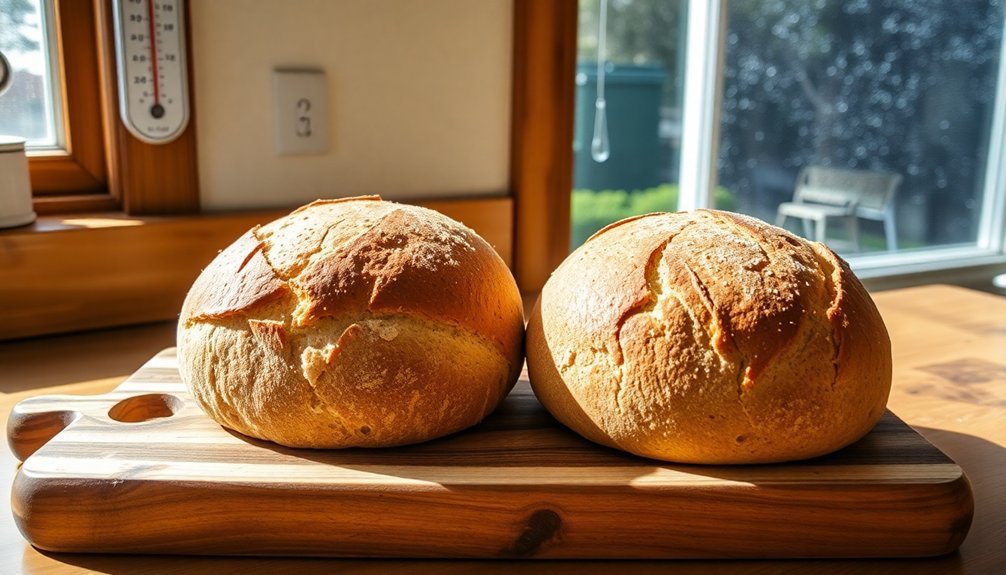
As bakers adapt their techniques throughout the year, the art of bread-making transforms with each passing season. You'll notice temperature adjustments are essential, with cooler 375°F ovens perfect for spring's enriched doughs, while summer demands hotter 450-550°F temperatures for crusty breads.
| Season | Bread Type | Temperature |
|---|---|---|
| Spring | Challah & Hot Cross Buns | 375°F |
| Summer | Ciabatta & Baguettes | 450-550°F |
| Winter | Dark Rye | Slow Rise, Cool |
Each season brings its signature breads: March's Irish Soda Bread celebrates St. Patrick's Day, while July's ciabatta makes perfect picnic sandwiches. You'll find November's cornbread gracing Thanksgiving tables, and winter's dark rye needs slower rising times to develop its complex flavors. These seasonal variations aren't just tradition—they're practical adaptations to changing conditions.
Wind Impact on Heat
When baking outdoors, wind presents one of the biggest challenges to achieving consistent heat levels.
You'll notice that wind can greatly affect your oven's temperature stability, especially in outdoor setups. The constant air movement forces your oven to work harder to maintain its target temperature, leading to increased energy consumption.
Wind's impact on heat distribution can create several issues for your bread:
- Cold drafts can cause uneven heat distribution inside the oven
- Temperature fluctuations may require longer baking times
- External winds can rapidly cool the oven's outer surfaces
- Air pressure changes can affect how heat circulates around your loaf
You'll need to monitor your oven's temperature more closely on windy days and possibly adjust your baking time or temperature settings to compensate for these environmental effects.
Time of Day Considerations
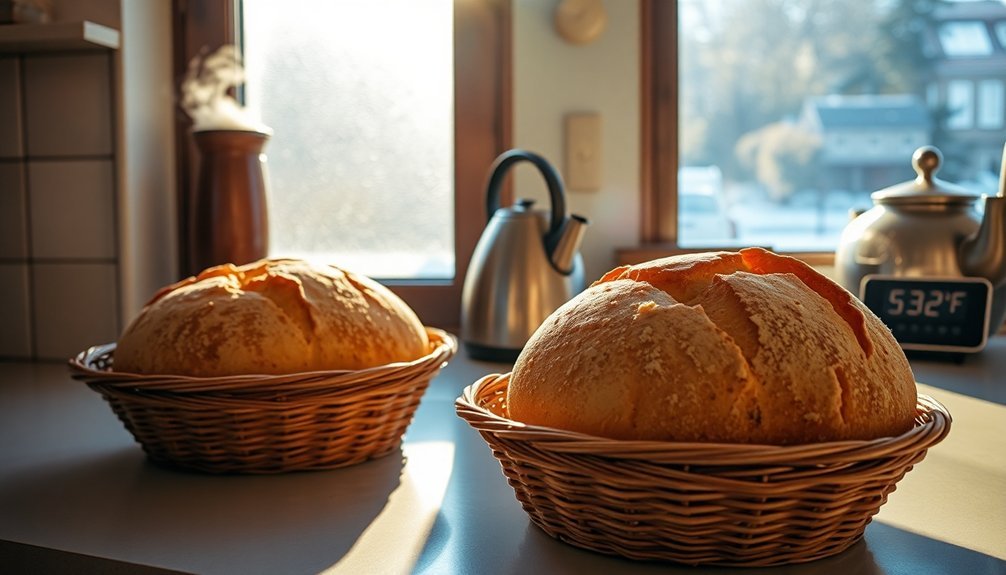
The time of day greatly impacts outdoor bread baking due to temperature fluctuations and solar exposure. When you're baking bread outdoors in the morning or evening, you'll need to adjust your timing since ambient temperatures are typically lower.
You'll find that temperature differences can notably affect fermentation rates and baking times. If you're working with enriched doughs containing butter and sweeteners, you'll want to maintain a consistent temperature closer to 350°F, which can be challenging during cooler hours.
For lean breads that require higher temperatures around 450°F, early afternoon baking might be more effective when the sun's heat can help maintain steady temperatures. Remember that longer, slower fermentation develops better flavor, so you might need to extend rising times during cooler parts of the day.
Altitude and Solar Baking
When you're baking bread outdoors at higher elevations, you'll need to account for the lower atmospheric pressure that makes dough rise faster but can lead to sudden collapses.
Your bread's structure will be greatly affected by the quicker evaporation of moisture and intensified sugar concentration at altitude, requiring adjustments to your ingredients and baking time.
If you're using solar heat for baking, you'll also need to take into account how the sun's intensity varies with elevation, as higher altitudes receive stronger solar radiation that can affect how quickly your bread bakes.
Atmospheric Pressure Impact
High altitudes create significant challenges for bread baking due to decreased atmospheric pressure, which dramatically affects how dough rises and bakes.
You'll notice your dough rising 25-50% faster than at sea level, but don't let this fool you – the results can be dense and disappointing if you don't make adjustments.
To succeed with high-altitude bread baking, you'll need to modify your standard recipe.
Here's what happens to your bread at high altitudes:
- Moisture evaporates more quickly, requiring 1-2 extra tablespoons of liquid per cup
- Yeast becomes overactive, needing a 15-25% reduction in amount
- Dough rises too fast, benefiting from double punch-downs
- Baking requires higher temperatures (15-25°F more) but shorter times
Remember to let your dough rise only to 1.5 times its size rather than double, and keep it covered to prevent moisture loss.
Sunlight Heat Variables
Baking bread in a solar oven presents unique challenges due to sunlight's variable intensity and cloud cover patterns.
You'll find that cloud coverage can greatly extend your baking time, sometimes up to two hours longer than expected. While solar ovens can reach impressive temperatures of 400°F, they struggle with maintaining consistent heat levels.
You'll need to monitor the weather carefully, as cloud interruptions can disrupt your baking process and affect bread quality. The browning of your crust begins at 120°C, but achieving even browning depends on steady sunlight exposure.
Temperature fluctuations will impact your bread's texture and crust formation. While you'll save electricity by baking outside, you'll need to accept that timing isn't as predictable as with conventional ovens.
Proper preheating and patience are essential for successful solar bread baking.
Dough Temperature Adaptations
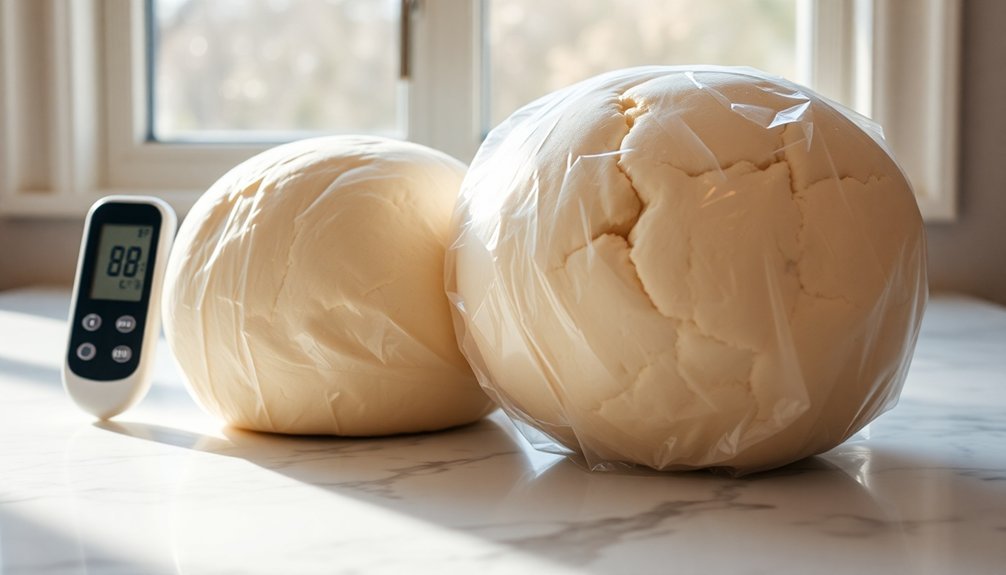
Since dough temperature dramatically affects bread quality, you'll need to adapt your techniques based on your environment.
Working outdoors means paying extra attention to temperature control, as even a few degrees difference can greatly impact fermentation times and final results.
To maintain ideal dough temperature between 75-78°F when baking outside, consider these essential adjustments:
- Use colder water on warm days to offset ambient heat and kneading friction
- Store your dough in an insulated container to protect it from temperature fluctuations
- Monitor dough temperature regularly with a digital thermometer
- Consider moving time-sensitive steps indoors if outdoor conditions are extreme
Remember that yeast becomes sluggish below ideal temperature and can die above 95°F, so you'll need to adjust your fermentation times accordingly.
For consistent results, focus on controlling variables you can manage, like water temperature and storage conditions.
Solar Heat Distribution
Modern solar heat distribution systems are revolutionizing outdoor bread baking through innovative rooftop mirror arrays.
You'll find large silver mirrors on bakery rooftops capturing and magnifying sunlight, which is then converted into heat energy. The system transfers this heat through a specialized fluid to reach baking temperatures of 300-400 Celsius in convection ovens.
You're looking at an efficient process that's cutting fuel bills by up to 80% while reducing diesel consumption by 10 tonnes per bakery monthly.
It's part of a larger initiative to eliminate diesel ovens by 2030. The technology's particularly impactful in places like Lebanon, where they're aiming to source 30% of electricity from renewables.
What's more, you're not just saving money – you're supporting a system that's creating jobs and making food more accessible during economic challenges.
Weather Pattern Challenges
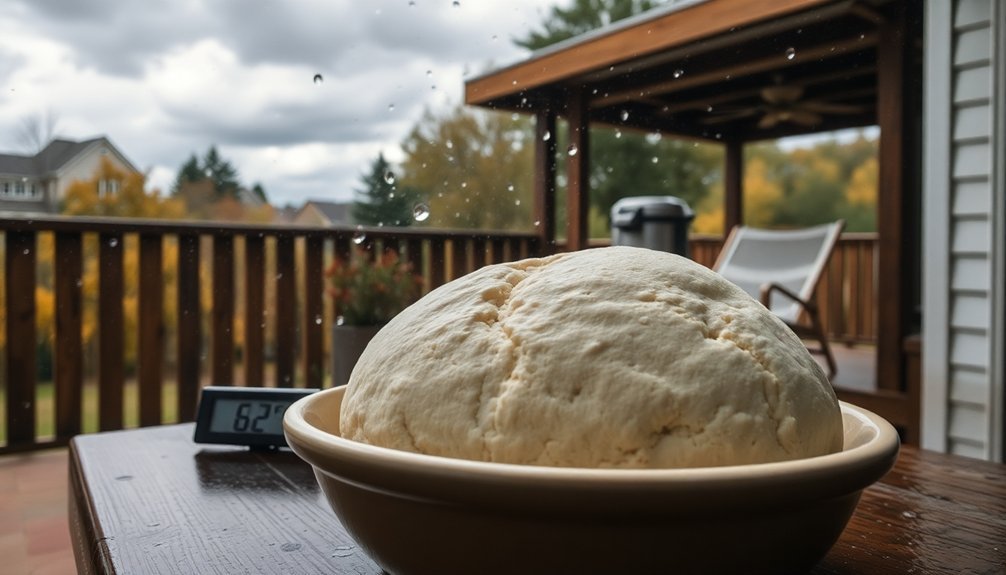
While solar heating systems offer precise temperature control indoors, outdoor bread-making faces a complex array of weather challenges.
You'll need to adapt your baking methods as weather patterns shift throughout the day and seasons. When humidity rises, your dough will take longer to ferment and may develop unevenly, requiring adjustments to liquid ingredients.
Key weather impacts you'll encounter:
- High humidity slows fermentation and creates denser bread texture
- Temperature fluctuations affect yeast activity – too hot kills it, too cold delays rising
- Changing air pressure at different altitudes alters rising times and moisture retention
- Variable conditions demand constant recipe adjustments, especially with liquids and leavening agents
Understanding these patterns helps you modify techniques and ingredients to achieve consistent results despite unpredictable outdoor conditions.
Ambient Temperature Factors
As you venture into outdoor bread making, understanding ambient temperature factors becomes vital for success. Your dough's behavior is directly tied to the surrounding air temperature, which affects how quickly or slowly your bread rises.
When you're baking outdoors, you'll notice that cooler temperatures slow down yeast activity, extending your rising time beyond what you're used to indoors. The preferred temperature range for bread making is between 70°F and 78°F, but outdoor conditions rarely stay this consistent.
Your flour temperature also plays a significant role, as it can be cooler than the air around it. To compensate, you'll need to adjust your water temperature carefully – keeping it between 110°F and 130°F for proper yeast activation. This helps maintain an ideal dough temperature of 75-79°F for fermentation.
Direct Sunlight Requirements
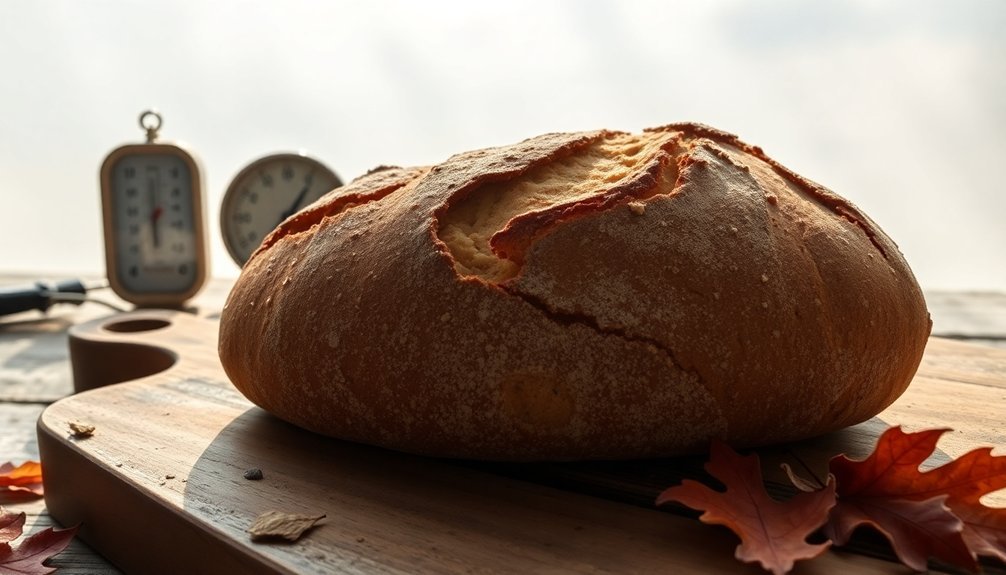
Since direct sunlight serves as your primary heat source, successful outdoor bread baking depends on proper sun exposure and positioning.
You'll need to align your sun oven correctly with the sun's rays and maintain clean seals to reach temperatures up to 350°F. Cloud cover can greatly impact your baking time, potentially extending it by 30-40 minutes if the oven isn't preheated.
For ideal results, you'll want to:
- Position your oven during peak sunlight hours (late morning to early afternoon)
- Adjust the oven's angle throughout the day to follow the sun
- Keep the oven free from any shade or obstruction
- Account for seasonal variations in sunlight intensity
Remember that winter months and early/late hours provide weaker sunlight, which means longer baking times.
Summer offers more intense sunlight, making your outdoor baking more efficient.
Proofing in Solar Conditions
Direct sunlight isn't the only factor to take into account when baking bread outdoors – proper proofing conditions play a major role in your success.
You'll need to adapt your proofing methods to overcome environmental challenges like temperature fluctuations, humidity levels, and barometric pressure changes that can slow down yeast activity.
Your dough's composition matters greatly when proofing outdoors. Make sure you're using the right flour type and yeast quantity, as these directly impact gluten formation and rise time.
If you're facing challenging weather conditions, consider alternative proofing methods. You can use a warm car interior, heating pads, or even slow-rise techniques in a refrigerator overnight.
Remember to monitor your dough closely and be prepared to adjust your schedule – outdoor proofing often requires more time than indoor methods.
Frequently Asked Questions
How Does Air Pollution Affect Outdoor Bread Baking Times?
Air pollution can slow your bread's baking time by altering humidity levels, affecting chemical reactions, and changing local temperatures. You'll notice pollutants interfere with proper oxidation and fermentation during the baking process.
Can Insect Activity Impact Dough While Baking Bread Outside?
Yes, insects can disrupt your outdoor baking by landing on the dough, contaminating it with bacteria, or affecting fermentation. You'll want to protect your dough with covers to prevent unwanted insect interference.
Will Nearby Construction Vibrations Affect the Bread's Rising Process?
You don't need to worry about construction vibrations affecting your bread's rise. While yeast prefers stable conditions, these vibrations won't greatly impact fermentation. Focus instead on maintaining proper temperature and moisture levels.
Does Electromagnetic Interference From Power Lines Affect Yeast Activity Outdoors?
You don't need to worry about power line EMI affecting your yeast. There's no scientific evidence that electromagnetic interference impacts yeast activity outdoors – temperature, humidity, and ingredients matter much more for fermentation.
How Do Different Ground Surfaces Affect Heat Reflection During Outdoor Baking?
You'll find that hard, flat surfaces reflect heat better than soft or uneven ground. When you're baking outdoors, a level, compact surface helps maintain consistent heat reflection and keeps your reflector oven stable.
In Summary
You'll find that outdoor bread baking times vary considerably based on multiple environmental factors. When you're using a solar oven, cloud cover, wind conditions, and the time of day directly affect your baking duration. During certain seasons or on overcast days, you'll need to allow extra time for proper bread rising and baking. Keep monitoring your dough and adjust your timing based on current weather conditions.





Leave a Reply